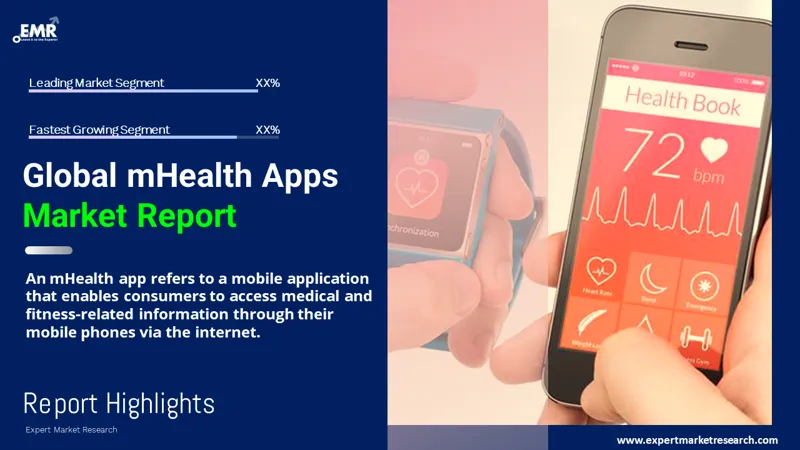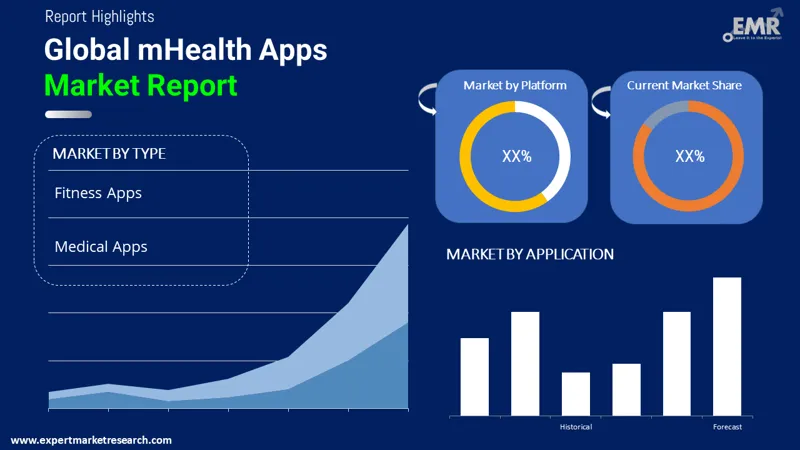
Consumer Insights
Uncover trends and behaviors shaping consumer choices today
Procurement Insights
Optimize your sourcing strategy with key market data
Industry Stats
Stay ahead with the latest trends and market analysis.
The global mHealth apps market was valued at USD 94.16 Billion in 2025, driven by the rising availability of technologically advanced mHealth apps across the globe. The market is further expected to grow at a CAGR of 17.80% in the forecast period of 2026-2035 to attain a value of around USD 484.53 Billion by 2035.
Base Year
Historical Period
Forecast Period
The rapid digitalization and the expansion of internet services are driving market growth across the globe.
A significant market trend is the integration of AI-powered voice-activated health assistants in mHealth apps.
Increased government initiatives directed at promoting the use of mobile health technologies in rural and remote areas are likely to fuel the market demand in the forecast period.
Compound Annual Growth Rate
17.8%
Value in USD Billion
2026-2035
*this image is indicative*
A mHealth app is a mobile-based application that helps consumers access medical and fitness-oriented information through their mobile phones via the Internet. The mHealth apps provide a range of services, including treatment support, health management, prevention strategies for illnesses, and monitoring symptoms, among others. Moreover, these apps facilitate digital consultations with medical practitioners, which helps to provide treatment for individuals at any location. In addition, the fitness apps offer suggestions, such as daily exercise routines related to maintaining a healthy lifestyle.
The rapid digitalization and the increasing spread of internet services across many countries are driving the expansion of the mHealth apps market. The rising mobile phone ownership is also contributing to the market growth significantly. Moreover, the COVID-19 pandemic accelerated the growth of the market, pushing many consumers to utilize mHealth apps for remote patient monitoring and diagnosis. Increased government initiatives directed at promoting the use of mobile health technologies in rural and remote areas are likely to positively influence the market dynamics.

Read more about this report - REQUEST FREE SAMPLE COPY IN PDF
Development of New Products to Impact Market Growth
In February 2024, Cedars-Sinai, a California-based non-profit healthcare organization reported the development of the 'EyePhone' mHealth app. This app can quickly identify strokes by using its eye-tracking technology, even in cases where vague symptoms such as dizziness are displayed by the patient. This tool is expected to emerge as a life-prominent innovation in stroke care by facilitating rapid and accessible stroke detection. The surge in the introduction of such advanced mHealth smartphone applications is poised to bolster market growth.
The market is witnessing several trends and developments to improve the current global scenario. Some of the notable trends are as follows:
Rise in Partnerships and Collaborations to Affect the Market Landscape Significantly
In February 2022, a startup specializing in mental health solutions, HealthRhythms, announced its partnership with the University of Colorado Health (UCHealth) to fuel the growth of its AI-based mental health app. This app uses AI to monitor the mental health status of the user and can predict depressive relapses. Such strategic collaborations are poised to stimulate growth and innovation in the market.
Emergence of Voice-Activated Health Assistants Likely to Augment mHealth Apps Market Demand
A significant market trend revolves around the development of voice-activated health assistants which are driven by artificial intelligence. These voice assistants can help in scheduling appointments, providing medication reminders, answering health-related questions, and offering health tips, making it easy for the user to manage their health. mHealth apps with this feature are increasingly becoming popular among older adults and individuals with disabilities.
Technological Advancements to Elevate the mHealth Apps Market Value
One of the major market trends is the rising technological advancements that improve the capabilities of mHealth apps. For instance, the integration of artificial intelligence (AI), machine learning, and data analytics in mobile health technologies is resulting in better health insights and predictive analytics. In addition, the development of advanced wearable devices allows continuous health monitoring and data collection. Such technological innovations are expected to elevate the market value.
Increased Government Initiatives to Boost mHealth Apps Market Size
The market is witnessing an increase in the number of government initiatives aimed at promoting the use of mobile health technologies. Such efforts, which also include funding for mHealth projects, are particularly directed at encouraging the adoption of mHealth apps in rural and remote areas where access to healthcare services is limited. This governmental support is likely to boost the market size in the coming years.

Read more about this report - REQUEST FREE SAMPLE COPY IN PDF
Market Breakup by Type
Market Breakup by Platform
Market Breakup by Application
Market Breakup by Region
Market Segmentation Based on mHealth Apps Type is Likely to Witness Substantial Growth
Based on the type of mHealth apps, the market is segmented into medical apps and fitness apps. The medical apps segment is divided into women's health apps, personal health record apps, medication management apps, diagnostic apps, remote monitoring apps, disease management apps, and others, whereas the fitness apps segment is further segmented into diet and nutrition, exercise and fitness, along with lifestyle and stress.
The medical apps segment in the mHealth apps market is predicted to account for a substantial market share. This increase can be associated with the rising incidences of chronic illnesses such as cardiovascular diseases, and diabetes, among others. In addition, the growing awareness pertaining to healthcare is driving consumers to utilize personal health tracking apps to monitor their eating habits and maintain a healthy diet. Moreover, the increased accessibility to medical professionals through these apps for all routine medical queries or any emergency assistance is also expected to positively catalyse the market growth in the forecast period.
North America is expected to occupy a substantial share of the market in the forecast period. This growth can be attributed to the increased acceptance of digital health technologies and the high prevalence of chronic diseases in the region. In addition, the rising demand for remote medical assistance, particularly for the geriatric population, is also a major contributing factor to the market growth. Moreover, the sedentary lifestyle, especially among the youth and the working population, is also leading to increased adoption of fitness apps in order to reduce the risks of obesity and cardiovascular diseases, among others. These factors are predicted to aid the market expansion in the region.
The key features of the market report comprise patent analysis, funding and investment analysis, and strategic initiatives by the leading key players. The major companies in the market are as follows:
Medical device company Abbott Laboratories, headquartered in Illinois, United States, is one of the leading players in the market. Abbott's FreeStyle Libre system is a popular product that helps in continuous glucose monitoring for diabetes management. The FreeStyle Libre app allows the monitoring of blood glucose levels in real-time on connected smartphones.
Samsung Electronics Co. Ltd., a South Korean multinational electronics company, has developed a range of mHealth apps and wearable devices in the healthcare domain. Samsung Health is one of their key products that tracks fitness activities, sleep patterns, heart rate, and other health parameters.
F. Hoffmann-La Roche AG, a Swiss multinational healthcare company, is widely recognized for integrating mobile health technology into its product offerings. The company is heavily investing in AI and big data to develop mHealth solutions with more personalized and predictive health insights.
American multinational corporation Apple, Inc. has a strong presence in the market and is actively engaged in continuous innovation in wearable technology. Its well-known product Apple Watch offers users a detailed view of their health metrics.
*Please note that this is only a partial list; the complete list of key players is available in the full report. Additionally, the list of key players can be customized to better suit your needs.*
Other key players in the market include Allscripts Healthcare Solutions Inc., Koninklijke Philips N.V., Airstrip Technologies Inc., Qualcomm Technologies Inc., AT&T, Veradigm LLC, Orange SA, and Teladoc Health, Inc.




*While we strive to always give you current and accurate information, the numbers depicted on the website are indicative and may differ from the actual numbers in the main report. At Expert Market Research, we aim to bring you the latest insights and trends in the market. Using our analyses and forecasts, stakeholders can understand the market dynamics, navigate challenges, and capitalize on opportunities to make data-driven strategic decisions.*
Get in touch with us for a customized solution tailored to your unique requirements and save upto 35%!
Explore our key highlights of the report and gain a concise overview of key findings, trends, and actionable insights that will empower your strategic decisions.
| REPORT FEATURES | DETAILS |
| Base Year | 2025 |
| Historical Period | 2019-2025 |
| Forecast Period | 2026-2035 |
| Scope of the Report |
Historical and Forecast Trends, Industry Drivers and Constraints, Historical and Forecast Market Analysis by Segment:
|
| Breakup by Type |
|
| Breakup by Platform |
|
| Breakup by Application |
|
| Breakup by Region |
|
| Market Dynamics |
|
| Supplier Landscape |
|
| Companies Covered |
|
Datasheet
One User
USD 3,299
USD 2,969
tax inclusive*
Single User License
One User
USD 5,499
USD 4,949
tax inclusive*
Five User License
Five User
USD 6,999
USD 5,949
tax inclusive*
Corporate License
Unlimited Users
USD 8,199
USD 6,969
tax inclusive*
*Please note that the prices mentioned below are starting prices for each bundle type. Kindly contact our team for further details.*
Flash Bundle
Small Business Bundle
Growth Bundle
Enterprise Bundle
*Please note that the prices mentioned below are starting prices for each bundle type. Kindly contact our team for further details.*
Flash Bundle
Number of Reports: 3
20%
tax inclusive*
Small Business Bundle
Number of Reports: 5
25%
tax inclusive*
Growth Bundle
Number of Reports: 8
30%
tax inclusive*
Enterprise Bundle
Number of Reports: 10
35%
tax inclusive*
How To Order

Select License Type
Choose the right license for your needs and access rights.

Click on ‘Buy Now’
Add the report to your cart with one click and proceed to register.

Select Mode of Payment
Choose a payment option for a secure checkout. You will be redirected accordingly.
Gain insights to stay ahead and seize opportunities.

Get insights & trends for a competitive edge.

Track prices with detailed trend reports.

Analyse trade data for supply chain insights.

Leverage cost reports for smart savings

Enhance supply chain with partnerships.

Connect For More Information
Our expert team of analysts will offer full support and resolve any queries regarding the report, before and after the purchase.
Our expert team of analysts will offer full support and resolve any queries regarding the report, before and after the purchase.
We employ meticulous research methods, blending advanced analytics and expert insights to deliver accurate, actionable industry intelligence, staying ahead of competitors.
Our skilled analysts offer unparalleled competitive advantage with detailed insights on current and emerging markets, ensuring your strategic edge.
We offer an in-depth yet simplified presentation of industry insights and analysis to meet your specific requirements effectively.
Share